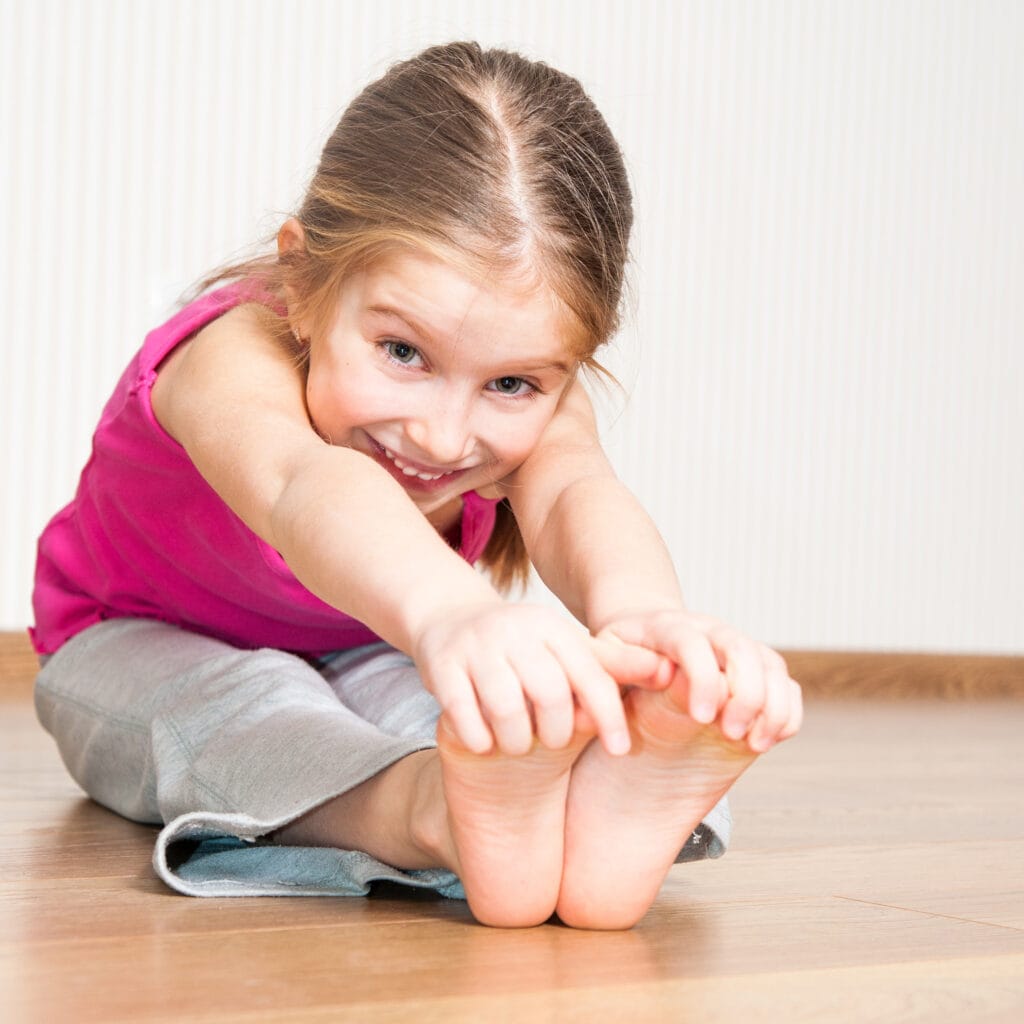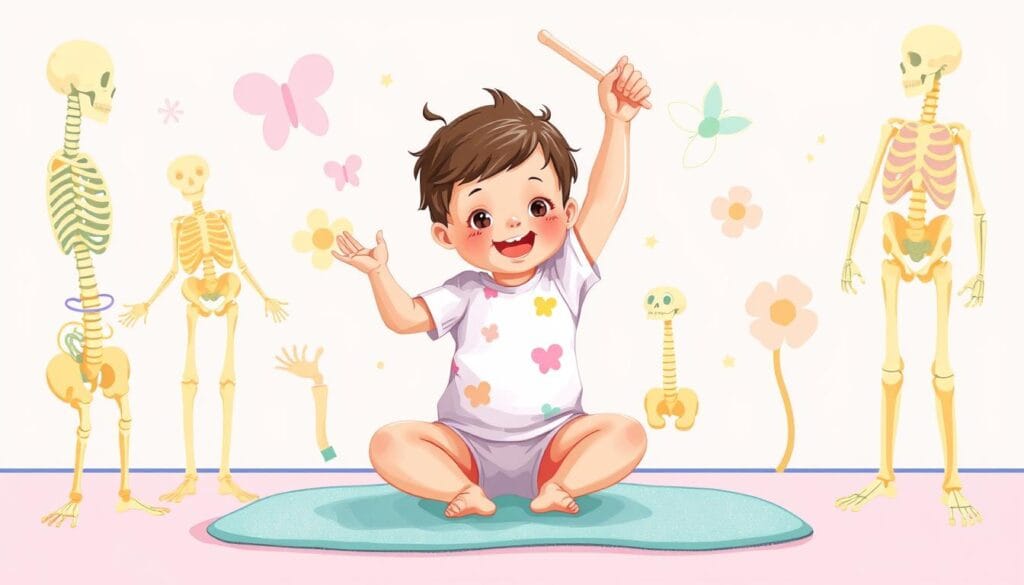As parents, we often wonder about our little ones’ physical limits. Can toddlers stretch their bones, or is that just a myth? This guide explores the science of bone growth in early childhood. It looks into how toddlers’ bones grow and become flexible.

Table of Contents
Understanding Bone Development in Early Childhood
Toddler bone growth follows predictable patterns. Leg length differences often stay the same as the child grows. Growth plates are key in bone development. Issues like infections or radiation can harm them.
This can cause leg length differences that may change over time. Knowing how bones grow and what can affect them is vital. It helps in diagnosing and treating bone issues in toddlers.
Natural Growth Patterns in Toddlers
About 5% of children have a bipartite patella. This is when the kneecap’s cartilage doesn’t fully fuse with the bone. It starts in kids aged 2 to 6, with the kneecap forming bone in multiple centers.
Role of Growth Plates in Development
Growth plates are essential for bone growth. Surgery might be needed for sesamoid bones in the foot. This is especially true if other treatments fail.
For knee sesamoid bones, surgery is more common. This is because special shoe inserts don’t work as well. If a child’s big toe or kneecap hurts, they should rest. If pain doesn’t go away after two weeks, see a doctor.
Factors Affecting Bone Growth
Many things can affect bone growth in toddlers. Infections, fractures, and radiation are examples. Knowing these factors is key for good toddler bone growth and childhood joint mobility.
“42 studies were initially found, with 12 included in the qualitative synthesis”
Healthcare professionals can better help young children by understanding bone growth. They can ensure kids stay mobile and have strong bones. This is crucial for their growth and health.
Can Toddlers Stretch Their Bones
Toddlers can’t stretch their bones like adults do, but they can do safe stretches. These stretches help them stay flexible and support bone growth. When kids grow fast, their muscles and tendons might get tight, leading to less flexibility and more pain.
During puberty, kids might lose flexibility because their bones grow faster than their muscles. Boys might lose flexibility as they gain muscle, while girls might stay flexible or even get more flexible because of estrogen.
It’s important for parents and coaches to understand how kids’ bodies change during puberty. This knowledge helps support young athletes, especially in sports that need flexibility like swimming or gymnastics.
Children should stretch every day for at least a minute to stretch their muscles. After a few weeks, they might start to feel better. But it can take longer to fully feel the benefits of stretching.
“Regular stretching until children reach skeletal maturity can correct issues caused by tight muscles, especially crucial for young athletes in competitive sports.”
Too much activity can cause pain in kids because their muscles are too tight. This is especially true for activities like running or throwing. Safe stretches can help prevent this pain and support bone health during important growth years.
The Science Behind Toddler Bone Growth and Flexibility
Toddlers grow fast, and their bones go through a lot. This process is key for their toddler bone development and childhood flexibility.
Bone Formation Process
Bone formation in toddlers is a balance between building and breaking down bone cells. This balance helps bones grow and change as the body needs. Genetics, nutrition, and exercise are important for bone health in toddlers.
Impact of Physical Activity on Bone Development
Exercise is crucial for healthy bones in toddlers. Activities that stretch and move the body help strengthen bones. This also boosts flexibility and keeps muscles and bones healthy.
“Studies have shown that dynamic stretching exercises during warm-up can acutely affect children’s fitness performance.”
Knowing how bones grow and how exercise helps is key. Parents and caregivers can support their kids’ growth. By choosing the right exercises and encouraging activity, they help with bone health in toddlers and childhood flexibility.
Common Bone Development Issues in Toddlers
Toddler growth and development is key for young bones’ health and strength. While most toddlers grow bones naturally and steadily, some face common issues. These can include leg length differences, “bowed legs,” “knock knees,” and Osgood-Schlatter’s disease.
Osgood-Schlatter disease (OSD) mainly hits preteens and teens, aged 10 to 15. It’s often caused by too much running or jumping, like in sports. It usually heals when bones stop growing, between 14 and 18 years old. But, rest, ice, compression, and elevation (RICE) can help during the active phase.
Spotting and treating these toddler growth and development problems early is vital. This helps avoid bone deformities for good. Regular check-ups and watching pediatric bone health can catch issues early.

Most bone issues in toddlers are short-term and can be managed well. But, if you’re worried, see a pediatrician or orthopedist. Early care ensures strong, healthy bones for your toddler’s future.
Safe Stretching Exercises for Growing Toddlers
Physical activity and stretching are key for toddlers’ growth. Just ten minutes a day can make a big difference in their health.
Age-Appropriate Movement Activities
Safe stretches for toddlers should be fun and active. They help muscles grow, reduce tightness, and boost flexibility. They also prevent injuries and promote a healthy lifestyle. Here are some good stretches for toddlers:
- Toe Touch: Gently reach for the toes, keeping the knees slightly bent.
- Neck Half Circles: Slowly move the head in half-circle motions, first to the left, then to the right.
- Shoulder Circles: Rotate the shoulders in circular motions, first forward, then backward.
Supervised Stretching Routines
Having a grown-up watch while toddlers stretch is important. It keeps them safe and helps them stretch right. A study showed that a three-minute stretch for kids is pretty active.
“Mixing active (motion-based) and passive (static) stretching exercises before physical activities can enhance performance and prevent injuries in young athletes.”
By adding safe stretches to their day, toddlers can stay flexible and healthy. They’ll also avoid muscle problems as they grow and play.
The Role of Physical Activity in Bone Health
Physical activity is key for toddlers’ bone health and growth. It helps prevent obesity and boosts flexibility. It also lowers the risk of bone and muscle problems.
Sports in schools can make kids more flexible and less prone to bone issues. Encouraging toddlers to play helps their bones stay strong for years to come.
Research shows that 60% of osteoporosis risk comes from bone mass built by early adulthood. Activities like brisk walking and dancing are best for growing bones. Kids need at least 7 months of such exercise to see bone mass changes.
“Children entering adulthood with greater bone mass (higher peak bone mass) may reduce the proportion of fractures suffered in old age by up to 50%.”
But, many teens don’t get enough exercise. They miss out on activities that help prevent fractures later. To keep bones healthy, kids should do weight-bearing and strength exercises.

Parents can help by limiting screen time and joining active outings. Adding physical activities to daily life boosts kids’ bone health and overall health.
Preventing Musculoskeletal Disorders During Growth
Keeping a toddler’s bones and muscles healthy is key for their well-being. Spotting growth problems early and using the right exercises can stop musculoskeletal disorders. Regular checks can find pain, stiffness, and diseases like Osgood-Schlatter’s disease, helping to act fast.
Early Detection of Growth Issues
Research finds that 10-20% of kids in elementary school and 30-40% in junior high have bone and joint pain. Also, 4% of elementary and 4.8% of junior high students get Osgood–Schlatter’s disease. This is a common problem during growth.
Proper Exercise Techniques
Using safe toddler stretches and activities right for their age helps keep joints moving. Short, brisk walks can improve flexibility without causing harm. This is good for avoiding injuries and keeping muscles healthy.
Developed stretching routines help prevent disorders and obesity in kids. Dynamic stretching is especially good for toddlers. It keeps them flexible and reduces pain and disorders.
“Over a third of bone mass is accumulated during the developmental age, reaching a peak around the second decade of life. Environmental factors like diet and exercise impact 20%-40% of peak bone mass in adulthood.”
Good posture, regular breaks, and ergonomic tools also prevent musculoskeletal disorders in kids. Being proactive and tackling issues early helps support healthy bone, joint, and muscle growth in toddlers.
Nutrition and Its Impact on Toddler Bone Development
Proper nutrition is key for healthy tohttps://en.wikipedia.org/wiki/Infantddler bone growth and development. A balanced diet with calcium, vitamin D, and protein is essential. It helps build strong bones in toddlers. This way, parents and caregivers can support optimal pediatric bone health and prevent growth issues.
Dairy products like milk, cheese, and yogurt are rich in calcium. They offer up to 300 milligrams per serving. This is a big part of what kids and teens need daily. Dark leafy greens, orange juice, soy, and fortified cereals are also good sources of calcium for toddlers.
Nutrients like magnesium, zinc, and vitamins C, D, and K are also important. Protein is crucial for bone formation and repair. A diet full of these nutrients helps build strong bones for toddlers. This sets them up for a lifetime of good bone health.
FAQ
Can toddlers literally stretch their bones?
No, toddlers can’t stretch their bones. Their bones grow naturally and have growth plates. While they can’t stretch bones, safe exercises help with flexibility and bone health.
What is the role of growth plates in toddler bone development?
Growth plates are key in bone growth. Problems like infections or radiation can harm them, affecting bone growth in toddlers.
What are some common bone development issues in toddlers?
Toddlers might face issues like leg length differences or “bowed legs.” These can be from birth or caused by infections or diseases.
How can stretching exercises benefit toddler bone and joint health?
Stretching keeps joints flexible and prevents pain during growth. It also boosts fitness and supports bone health.
What are some safe and age-appropriate stretching exercises for toddlers?
Toddlers can do fun stretches like lifting arms or legs. These exercises are safe and help prevent health issues.
How does physical activity impact toddler bone health?
Exercise is vital for bone health in toddlers. It prevents obesity and improves flexibility. It also lowers the risk of musculoskeletal disorders.
What role does nutrition play in toddler bone development?
A balanced diet with calcium and vitamin D is crucial. It supports strong bones and prevents growth problems.
